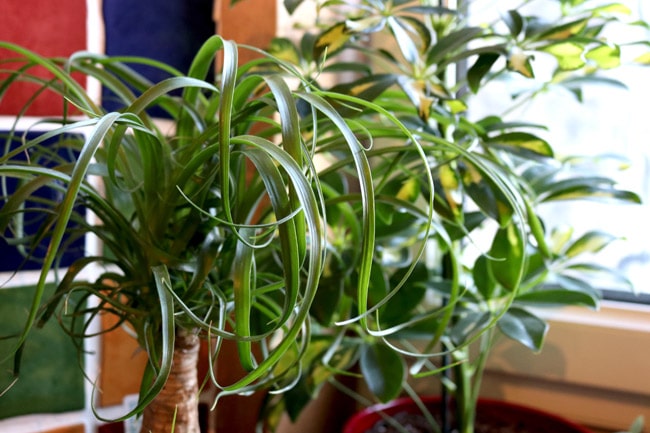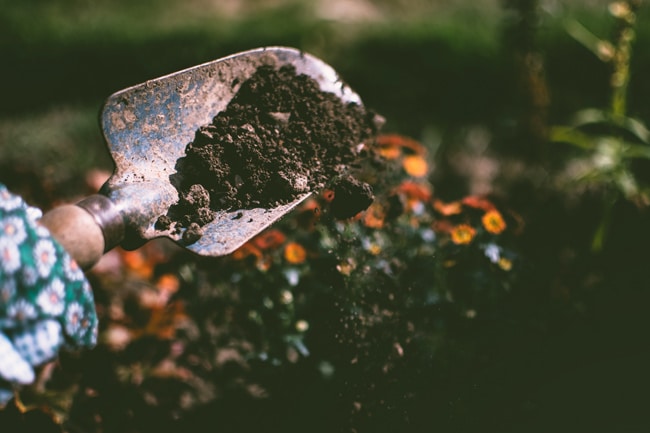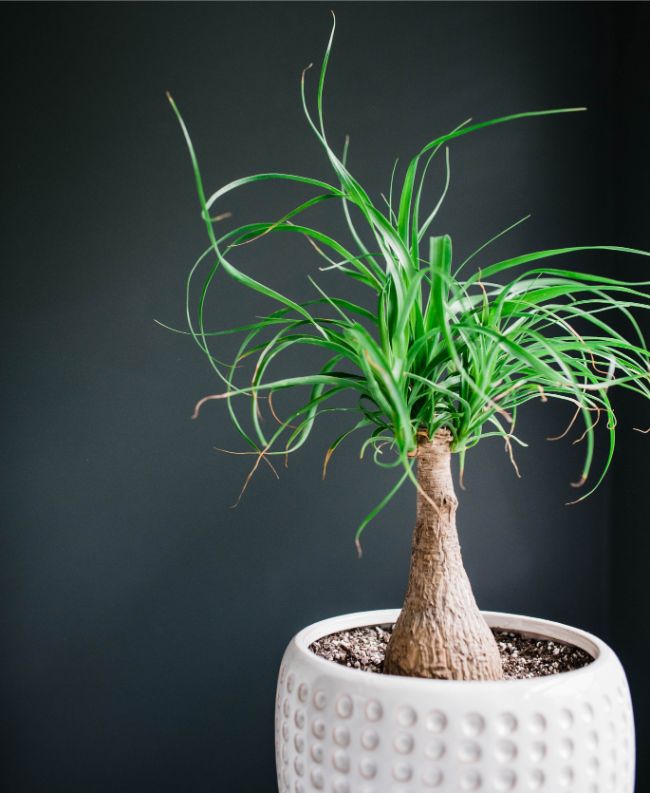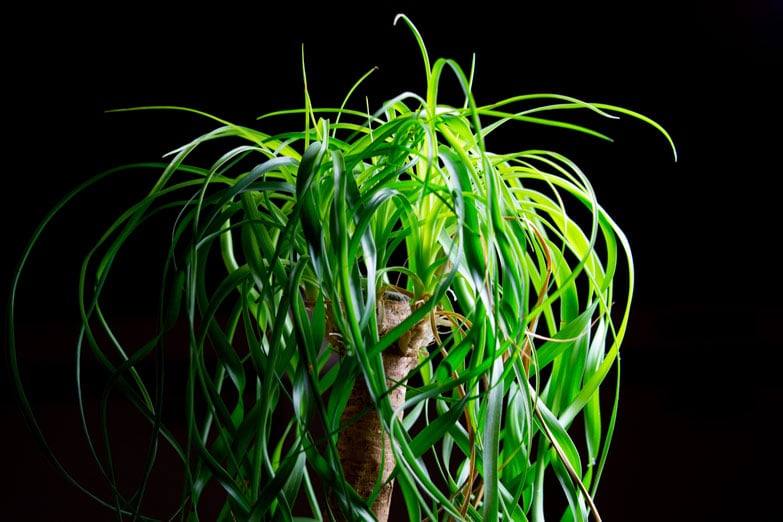Ponytail palms are a great houseplant because they’re easy to care for, look very striking, and can live for a really, really long time. That said, one of the common issues with this plant is the tips turning brown. The truth is that there are a lot of reasons why this happens and it’s not always easy to figure it out.
Why Does Your Ponytail Palm Have Brown Tips? The most common reason is overwatering, though a lot of other factors come into play. Not enough light, the wrong soil in the wrong pot, underwatering or using too much fertilizer are all contributing factors.
If your ponytail palm has brown tips, it may take some time to figure out the exact cause of the problem but, in most cases, it isn’t difficult to correct the problem. To learn a little more about this plant and what you can do to keep yours green and healthy, read on.
All About The Ponytail Palm
The ponytail palm is a gorgeous house plant that’s pretty easy to take care of but one problem that commonly occurs is the tips of the leaves turning brown. If you’re here because you’re looking for a way to fix this problem, don’t worry, I’m here to help. But first, let’s take a look at a bit of background information about the ponytail palm.
To start, something interesting about the ponytail palm is not a palm tree at all. It got its name from its single trunk and long, thin-grass like leaves that resemble a palm but this plant is actually a succulent. Because of this, it’s easy to propagate and can completely regrow its top.
When potted indoors, these plants get about four feet high. If grown outside without any restrictions, they can reach thirty feet tall. These plants are native to eastern Mexico are prefer a dry, hot environment.
This is useful information to keep in mind when you have one of these plants in your home because it gives you some idea of the type of environment they prefer. A ponytail palm is a desert plant that’s pretty durable and doesn’t need a lot of water to stay healthy.
Why Does My Ponytail Palm Have Brown Tips?
Brown tips are a pretty common problem for ponytail palms but the cause is not always straightforward. Brown tips can be caused by a single issue or a combination of issues. Sometimes, the solution is pretty easy but it can take some detective work to figure out what to do. Here are some of the most common culprits.
Overwatering

The most common cause of brown leaf tips in ponytail palms is overwatering. As I mentioned, this plant is native to the dry and hot region of eastern Mexico where there isn’t much rainfall. Plants that grow here have many unique traits that allow them to not only live in these rugged conditions but also to thrive in them.
Consequently, the traits that help these plants thrive in the dry, hot climate of eastern Mexico are the same traits that lead to problems when they’re kept as houseplants.
To survive in the desert, the ponytail palm has to rely on its strong, robust root system to soak up and store what little water was available and hold onto it for long periods of time. When the plant receives too much water, the roots become oversaturated and begin to show signs of distress, including – you guessed it – browning of its leaves.
If overwatering is the problem, you’ll also notice that the trunk of the plant becomes soft and mushy and the roots will begin to deteriorate and develop root rot. If you don’t change your watering habits when these signs appear, your beautiful Ponytail palm will eventually die.
To avoid these issues and keep your ponytail palm healthy, there are some guidelines to follow as to when and how much you water it. This can be a little tricky because the amount of water you give to your ponytail depends on several factors, including the amount of light it receives, how large it is, and the consistency and mixture of its soil.
You should also consider the room temperature, pot size, and how often the plant is fertilized. To make this a little easier, let’s look at each of these factors to understand what is optimal for the ponytail palm.
Underwatering
At the other end of the spectrum, brown tips on ponytail palms can be due to underwatering. Although well suited to periods of drought, even this hardy plant has its limits.
A ponytail palm left without water for long enough will start to become stressed, and the leaf tips will begin to turn brown and die. Although this will affect the aesthetics of your plant, it is a survival mechanism. The ponytail palm prioritizes keeping central tissues of the plant hydrated at the expense of the leaf tips.
Identifying underwatering is easy as when you feel the soil, it will be as dry as dust. The pot will feel light due to the lack of water content and the soil will be dry from bottom to top.
Remedy this situation by watering your ponytail palm thoroughly. Completely saturate the soil. I often take a plant like this to the sink and water from the top, while letting the sink partly fill with water for a few minutes. This gives the plant extra time to absorb the available water.
Just make sure you drain the plant well after a few minutes so the soil is not left soggy. Don’t compensate for underwatering by starting to overwater. Just resume a normal watering routine, checking the plant and soil every few days and waiting until the top 2-3 inches of soil has dried before adding more water.
Insufficient Light
In regards to light, the ponytail palm cannot get enough and absolutely thrives when exposed to it for long periods of time. Placing your ponytail palm in a well-lit spot is an easy way to make sure it thrives. You don’t need to go overboard and stress about making sure each and every leaf is getting enough light but do make sure it’s getting as much light as possible.
There will be times during the winter months that the light isn’t going to be as consistent but it should still be good enough for the ponytail palm thanks to it durable nature. Sometimes, people keep their ponytail outside during the summer months, which is helpful as it allows the plant to store excessive amounts of energy from the light for use over the coming winter. Doing this is certainly helpful but it’s not completely necessary.
In somewhat rare cases, too much sunlight can cause the ponytail to develop brown tips but this is usually the result of way too much light and little to no water for an extended period of time. You would really have to go months without watering your ponytail to see these effects.
Soil And Potting Problems

The soil mixture that is best for the ponytail and makes it easier to avoid brown leaf tips is a combination of perlite, sand, and regular potting soil. Use equal parts of each in a pot until there are only a couple of inches of space at the top and around the edges. You should also ensure that the pot has drainage holes in the bottom so that any excess water can seep out safely.
The trunk of the plant must stay above the soil line. If it’s buried, the trunk will surely rot. The pot size should be evaluated based on the size of the plant and the temperature of the room which should be anywhere between sixty and eighty degrees.
Finally, fertilizer isn’t required but adding a little in the spring and maybe once in the summer can help a malnourished plant bounce back. Over-fertilizing will cause the leaf tips to brown so use sparingly and only add about a fourth of what the directions recommend.
Proper Care To Prevent Brown Tips On Your Ponytail Palm
Following these guidelines helps you avoid overwatering and keeps your ponytail palm’s leaf tips nice and green. Each of the factors I mentioned above has a direct impact on the watering procedure and after effects, so they should not be taken lightly.
Now, as far as the amount and frequency of water your ponytail can handle without turning brown, the rule to live by is the drier the better. Only water your ponytail palm once at least the top 2-3 inches of soil has dried out. How long this takes will vary from plant to plant because each environment is a little different but these are the general guidelines to adhere to avoid brown leaf tips on your ponytail palm.
When watering your ponytail palm, soak the entire pot with room temperature water then allow it to soak through to the bottom of the pot and drain for several minutes. It’s very important to give the plant enough time to sit in the water that has collected in the drip pan but not for much longer than five to ten minutes.
Next, remove the drip pan and pour out the excess water. You should also make sure to avoid getting a ton of water on the trunk as this will cause it to rot. Your next round of watering will be about two to three weeks later or when you begin to notice that the top two to three inches of soil is completely dry.
Using only your eyes to determine how dry the soil isn’t enough because you can’t determine how much moisture remains underneath. For accuracy, stick a finger into the top few inches of the soil to ensure that the soil is completely dry and the plant is ready for watering.
How To Prevent Brown Tips On A Ponytail Palm Due To Overwatering

If you suspect that your ponytail palm’s leaves are brown from overwatering, there are a few things you can look for to verify.
Before the tips of the plant turn brown, you may notice some other changes in the foliage. They may wilt, take on a yellow hue, and even fall off the tree. If you dig into the soil and see that the roots are brown instead of white, it’s likely root rot has set in.
Continuing to water the plant in this condition will cause the roots to decay but, if they dry out and the rotten parts are removed, the roots can regenerate and the plant can heal.
If you notice this, stop watering the plant and allow it to dry completely. Too much water also causes the stem to rot which prevents nutrients from moving through the plant. When it dries, the plant can heal itself and recover without the need for extra fertilizers but it’s important to catch the damage early so you can try to turn it around.
Another way to tell if your ponytail palm is overwatered is if it stops flowering. Now, this isn’t a very reliable way to tell because these plants don’t flower often. In fact, it may take up to 30 years or so to see an adult ponytail palm flower indoors. But, if you’ve had your plant for a really long time or if you received it as a hand-me-down from someone who has had it for a while, it is possible.
Ponytail plants that are overwatered to the point where the leaves turn yellow and brown do not have enough chlorophyll to produce the energy needed to bloom. Even if the watering problem is corrected, it can take a year or more for the plant to recover enough to grow a healthy bloom.

